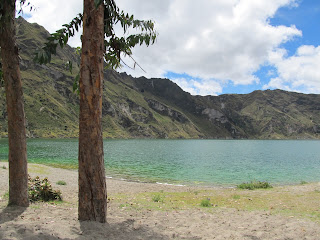The final part of our trip was visiting the Highlands south of Quito. The area is known as the Avenue of Volcanoes because there are so many there (10+).
We visited an old hacienda (grand estate) on the drive there.
With beautiful furniture.
And a eucalyptus-tree lined driveway, which was pretty impressive. There are plenty of these old-style houses around, mostly used as hotels nowadays.
Much of the highlands looked like this - mountains with winding roads, trees and fields everywhere.
Ecuadorian houses in the highlands, with laundry hanging everywhere and mountains in the background.
They don't use terracing in Ecuador - if their field is on the side of the mountain, they just deal with it.
Some local people looking after their sheep in a field.
We visited a local market on the way there, which was a riot of colorful costumes and loud Spanish. It's hard to see from the photo, but most of the people are wearing traditional outfits - it's not a tourist market, that's just what they do. Most of the women wear black panama hats, black skirts and brightly colored shawls, and the men wear the same hats with colorful ponchos over the top. You should be able to click on the picture to see a bigger version.
We visited Quilotoa Lake, which is in yet another volcano crater. Unfortunately I couldn't get far enough back to fit the whole lake in one photo! We were slightly crazy and decided to walk down to the lake for lunch - the vertical distance was 400m.
It only took us 30 minutes to get down...
... but it took us nearly 2 hours to get back up. The lake's at around 4000m above sea level, so strenuous uphill walking was more strenuous than normal.
We visited Cotopaxi volcano, but unfortunately this is the best picture we got as the weather was not cooperating. Cotopaxi is 5,897m high.
We decided to walk up to the climbers' refuge at 4800m, where climbing expeditions to the summit start from.
Unfortunately we weren't really dressed for the conditions - it was hailing and icy cold, maybe 5 degrees C temperature, and our shorts weren't cutting it.
So we stopped at 4610m and went back down again for a warm lunch. Hey, it was our vacation!
On the way down, we were overtaken by some local nuns, who had walked up to the refuge and were on their way back down again. This made us feel rather wussy about going back down, so we consoled ourselves with delicious Andean soup for lunch.
A signpost showing nearby volcanoes - I did say it was called Avenue of Volcanoes for a reason!
A llama... or is it an alpaca? We have no idea!
The next day dawned bright and sunny, and we could actually see Cotopaxi volcano! Here's the top part. Now if you can imagine this and the previous picture together, you should get an idea of how big the volcano is.
Cotopaxi behind our hotel. You can see that the clouds are rolling in already.
We spent our last day in Ecuador riding horses in the Andes. I had checked specifically the day before with our guide that we would not be required to wear any stupid outfits to ride horses, and he said no, absolutely not. Apparently that wasn't actually true. Stephen quite enjoyed his outfit.
Here's me with Cotopaxi in the background on my horse, also known as the laziest horse of all time. It wouldn't go faster than a walk. You can see the clouds rolling in - it started hailing about 90 minutes in to our 4 hour horse ride, which wasn't much fun for us or the horses.
Mountains and rolling plains - the scenery of our horse ride.
Leaving the Highlands for home.
All in all Ecuador was a nice place to visit - the people we met in the Highlands were lovely and seemed really excited about people visiting their little corner of the world (in stark contrast to the people of the Galapagos). The food was great, the scenery was beautiful and there were plenty of interesting things to see. We highly recommend it - although we'd recommend more time in the Highlands than on Galapagos :)
This is Part 3 (Highlands). Part 1 (Quito) and Part 2 (Galapagos Islands) are also available.















































